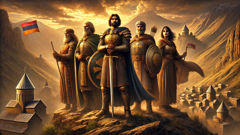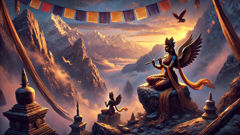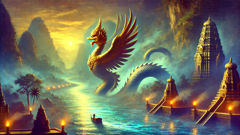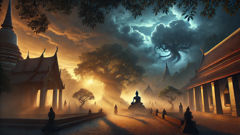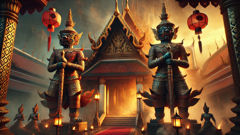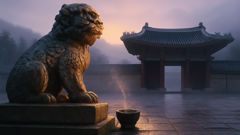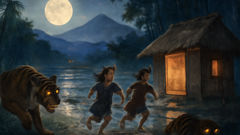Introduction
Beneath the shadowy slopes of Mount Aragats and the rugged peaks of Sassoun, the land of Armenia thrummed with ancient tales. In these wild highlands—where forests whispered with pines and rivers rushed in silver torrents—villages nestled like secret gems, their stone houses clustered together for warmth and safety. Here, the mountain wind spoke of heroes, and the very earth seemed steeped in legends. Over centuries, Armenia’s people endured invasions and upheavals, yet their spirit never broke. Out of this fierce resilience rose stories so grand that they echoed across generations—the greatest of which was the saga of the Daredevils of Sassoun. This was a land where heroism was woven into daily life and valor was as natural as breath. The epic of Sasuntsi Davit did not begin with one man alone; it unfurled across four generations, each hero born of struggle and hope. It was a time when faith and sword, song and silence, fate and love shaped destinies. The mountains witnessed four mighty sons: Sanasar and Baghdasar, twin founders and miracle children; Mher the Great, whose strength could shatter armies; the famed Davit, lion-hearted protector and Armenia’s pride; and Mher the Younger, whose tragic wisdom brought the saga full circle. Their stories entwined with the land—every boulder and spring seemed to bear their mark. In taverns by the fire and under star-laden skies, these tales inspired not just Armenians but all who heard them, lighting flames of courage against overwhelming odds. Now, as we return to medieval Sassoun, the clamor of battle drums and laughter of village children carry us back to a time where giants strode the earth, the line between myth and reality blurred, and one family’s valor became a beacon for a nation.
Roots of Valor: Sanasar and Baghdasar
Long before the storm of war thundered across Armenia, the land was watched over by a wise and gentle king, whose heart ached with longing. For years, King Tovmas of Tsovinar ruled his green valley with justice, but the gods had denied him an heir. His prayers, whispered at ancient shrines and under the blue arc of the sky, finally stirred the fates. One rain-soaked night, as thunder cracked over the highlands, his wife Queen Tsovinar drank from a sacred spring at the foot of Mount Aragats—a spring said to flow with the blood of the earth. Not long after, she gave birth to twins: Sanasar and Baghdasar.
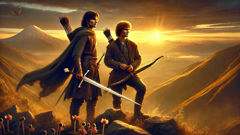
Sanasar grew tall and powerful, his voice echoing like rolling thunder, while Baghdasar’s quick mind and sharp wit made him a favorite among elders and bards. The brothers were inseparable, their bond forged in laughter and playful rivalry. As boys, they raced through mountain meadows, leaped over streams, and chased wild goats along perilous cliffs. But theirs was not a life of idle joy. From the moment they could walk, their father taught them the weight of a sword and the meaning of honor. Stories of far-off invaders and broken alliances hung over their childhood like storm clouds.
The first true test of their courage came when a fearsome Arab lord, Mleh, invaded the valley, his warriors pillaging villages and desecrating shrines. At dawn, Sanasar strode out with a mighty spear in hand, his long hair streaming in the wind. Baghdasar followed with his curved blade, eyes alight with cunning. On the field of Khar, as the enemy’s banners fluttered, the brothers unleashed their might. Sanasar cleaved a path through armored cavalry, while Baghdasar darted and weaved, his laughter mocking the invaders. Their teamwork was a symphony—one’s brute force met by the other’s finesse. Even as arrows darkened the sky, neither faltered. The people watched in awe as the twins fought back the tide, saving the valley from ruin.
But victory did not bring peace. The brothers soon discovered a deeper calling. Guided by dreams and the cryptic words of an old hermit, they climbed Mount Sassoun, where the wind howled and the stones glowed in the sunset. There, they unearthed relics from forgotten ages: Sanasar drew forth a massive sword buried in rock, its blade still sharp as the day it was forged; Baghdasar found a bow strung with silver hair, able to shoot arrows farther than any mortal archer. The mountain itself seemed to accept them as its sons, bestowing strength and wisdom beyond ordinary men.
With these gifts, Sanasar and Baghdasar became rulers of Sassoun, transforming it into a haven for the free and the brave. They built stone fortresses along mountain passes and taught their people to defend what was theirs. The fields flourished and the rivers ran clear. Tales spread far and wide—of twins who could slay lions, leap across chasms, and outwit any foe. And yet, their greatest legacy was not in war but in the peace they fostered. Sanasar, ever restless, would wander the hills to listen to the wind’s secrets, while Baghdasar—more at ease among people—sat by fires to hear their worries and dreams.
As their hair grayed and their strength waned, the brothers looked to the future. Sanasar’s wife, the wise Lady Arevik, gave birth to a son whose fate would eclipse even theirs: Mher the Great. The roots of valor planted by Sanasar and Baghdasar would one day blossom into legends that neither time nor invader could erase.
The Lion of Sassoun: Mher the Great
The passing of Sanasar and Baghdasar left Sassoun in mourning, but their legacy lived on in Mher, the son of Sanasar and Lady Arevik. As a child, Mher possessed strength that startled even the boldest warriors. At age five, he broke a wild stallion to his will; at ten, he split boulders with his bare hands. Yet his greatness was not measured by strength alone. His heart was open, his laughter infectious, and his sense of justice absolute. In the halls of Sassoun’s castle, he listened to old men’s tales and young girls’ songs, absorbing the wisdom of the land.
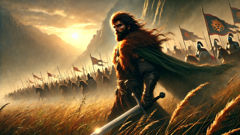
It was in Mher’s time that the threat from the south grew dire. Melik Fadl, the Arab overlord ruling from distant Msis, grew envious of Sassoun’s freedom. His armies, clad in black armor and bearing crescent banners, descended upon Armenian lands like a plague. Mher, now a young man, vowed to protect his people as his father and uncle had. He summoned the council and spoke with a voice that rang like iron: “As long as I draw breath, no invader shall cross these mountains.”
When Melik Fadl’s forces camped at the foot of Sassoun, Mher strode into their midst alone. The enemy soldiers jeered, thinking him mad. But Mher stood like a rock in a torrent. He called out to Melik Fadl, challenging him to single combat. The Arab lord, confident in his champion—a giant known as Zhul—accepted. Before the eyes of thousands, Mher and Zhul clashed. Swords sparked, shields shattered. Mher fought as if possessed, his mighty blade cleaving through iron and bone. At last, he flung Zhul aside and faced Melik Fadl himself. The overlord trembled, realizing too late that no ordinary man stood before him.
Yet Mher was not cruel. He spared Melik Fadl, demanding only that he swear an oath never to invade Armenia again. Humbled and terrified, Melik Fadl agreed, and his army withdrew. The people of Sassoun celebrated for days, singing of Mher’s courage. But peace was fleeting. Melik Fadl, stung by defeat, plotted revenge. He sent assassins cloaked in darkness; he poisoned wells and bribed traitors. Each time, Mher thwarted him, earning the nickname “Lion of Sassoun.”
Mher’s life was not without sorrow. He fell in love with the beautiful Armenuhi, a noblewoman renowned for her wisdom and grace. Their wedding united rival clans and brought brief hope of lasting unity. But soon tragedy struck: Armenuhi died giving birth to their only son, Davit. Mher’s grief was deep, but his sense of duty remained unshaken. He raised Davit with gentleness, teaching him to temper strength with mercy and to see every villager as kin.
As years passed, Mher grew gray and weary. One final battle awaited—a desperate defense against a massive coalition of Arab princes. In a storm of blood and steel, Mher fought until the rivers ran red. At last, surrounded on all sides, he hurled his sword into the enemy’s ranks and vanished into legend. Some say he was swallowed by a mountain cave; others believe he became a spirit watching over Sassoun. All that remained was his son, Davit, left to carry the flame.
The Heart of Armenia: Sasuntsi Davit
If Mher was a lion, his son Davit was a tempest—fiery, stubborn, and impossibly brave. Raised among warriors but orphaned by fate, Davit became Sassoun’s greatest hope. In childhood he was wild, chasing mountain goats and wrestling older boys in the village square. Yet beneath his mischievous grin was a will like forged steel.
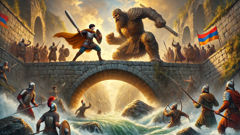
The shadow of Msis still darkened Armenia. The treacherous Melik Fadl had died, but his son, Melik Fadl Junior, was even more ruthless. He sought to conquer not just land but spirit, sending spies and sowing discord among the clans. Davit watched as old allies turned on one another, their trust corroded by gold and fear. He could not abide this. At sixteen, armed with his grandfather’s sword and astride his faithful horse Jalali—a stallion said to be born from lightning—Davit rode from village to village, rallying the people. His voice rekindled hope; his courage stoked rebellion.
Davit’s legend grew swiftly. Once, when Melik Fadl’s armies besieged Sassoun, Davit challenged their champion—a monstrous giant wielding a tree-trunk as a club. The two met on a bridge over the roaring river Aratsani. The clash shook the stones. Davit, outmatched in size, fought with dazzling speed and wit. At the last moment, he ducked under the giant’s swing, tripped him with a sweep of his leg, and flung him into the rushing water below. The enemy fled in terror.
But Davit’s trials were not only on the battlefield. He faced betrayal from within: a cousin seduced by promises of wealth plotted to hand Sassoun to the Arabs. Davit uncovered the plot but spared his cousin, exiling him instead of executing him. “Let mercy temper justice,” he said, “so that our enemies cannot claim we are like them.” This act endeared him to his people and confounded his foes.
Davit’s greatest challenge came when Melik Fadl Junior captured a thousand Sassoun villagers and threatened to slaughter them unless Davit surrendered. With no other choice, Davit rode alone to Msis. There, in the ornate palace, he faced Melik Fadl Junior before a jeering court. Refusing to bow, Davit demanded the release of his people. The lord laughed and ordered him thrown into a pit of lions. But Davit, recalling his ancestors’ strength, wrestled the beasts into submission and emerged unscathed. His defiance so inspired the palace guards that they mutinied, freeing the prisoners and driving Melik Fadl Junior into exile.
Davit returned to Sassoun triumphant. Yet he carried scars—memories of loss and the burdens of leadership. He married the wise Khandut and became a father to Mher the Younger, vowing to teach him not only to fight but to heal. Under Davit’s rule, Sassoun enjoyed its greatest era: villages flourished, crops grew tall, and songs of victory filled the air. But as all legends do, his tale too would pass into the hands of the next generation.
The Final Light: Mher the Younger
Mher the Younger was born into peace hard-won and dearly kept. His father, Davit, showered him with both affection and high expectations. From an early age, Mher showed talent not only in swordplay and horsemanship but in reading the winds and listening to the land’s quiet voices. Where Davit was fire, Mher was water—calm, deep, and thoughtful.

As Mher grew to manhood, dark clouds gathered anew. The world outside Sassoun was changing; Arab warlords grew bold again, sensing weakness in Armenia’s fractured alliances. Mher’s counselors urged preemptive war, but he hesitated. He saw in his dreams the pain that violence would bring—not just to enemies but to his own people. The wisdom of his ancestors weighed heavily on him.
A new Arab chieftain, Zengi, sought to end Sassoun’s independence once and for all. He assembled a vast army and marched on the highlands. Mher answered the call but chose a path unseen before: he rode out alone, bearing neither sword nor shield but a simple staff of olive wood. Before Zengi’s legions, he spoke not of hate but of kinship—reminding them that all were children of the same earth. Zengi, shamed but prideful, challenged Mher to combat. The duel was fierce yet dignified. Mher bested Zengi not with brute force but with clever feints and unmatched agility.
The people cheered, believing peace would follow. But Zengi refused to accept defeat. He unleashed a night attack on Sassoun, burning fields and slaughtering innocents. Enraged and heartbroken, Mher fought back with devastating skill. He routed the invaders but could not save all he loved. The cost of victory was too high; Mher realized that endless war would only breed more sorrow.
In the aftermath, Mher rode to a sacred cave high above Sassoun—the very cave where his grandfather Mher the Great was said to have vanished. Entering its shadowy depths, he spoke to the spirits of his ancestors, asking for guidance. Legends say the mountain itself replied: “Rest now, child of Sassoun. One day, when the world is ready for true peace, you shall return.”
Mher sealed himself within the cave. The villagers mourned, yet felt hope stir in their hearts. For as long as Armenia remembered the Daredevils of Sassoun, their courage would never die.
Conclusion
The saga of the Daredevils of Sassoun endures not just in words but in the living spirit of a people who refuse to yield. Across centuries and through countless retellings, Sanasar and Baghdasar’s founding courage, Mher’s indomitable strength, Davit’s fierce compassion, and Mher the Younger’s profound wisdom have become more than legend—they are woven into Armenia’s soul. These heroes teach that real bravery is not only found on the battlefield but also in the choices we make when faced with fear or loss. They remind us that leadership means sacrifice; that mercy can be mightier than the sword; and that sometimes, true victory lies in knowing when to set aside arms for peace. In every Armenian village where stories flicker by firelight, and in every heart longing for freedom, the echoes of Sassoun’s daredevils live on. The mountains still stand guard over their homeland, and one day—when darkness threatens again—the sons of Sassoun may yet return.

